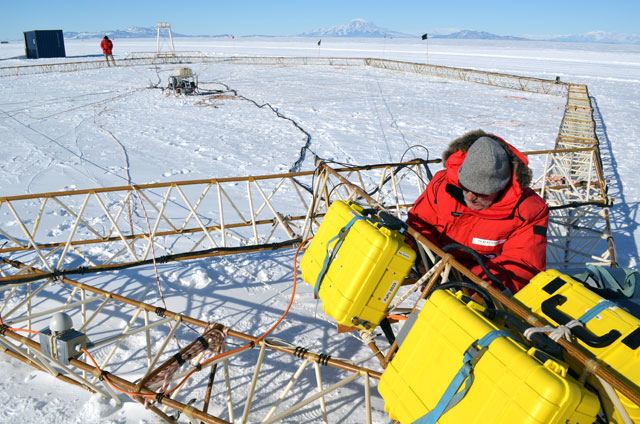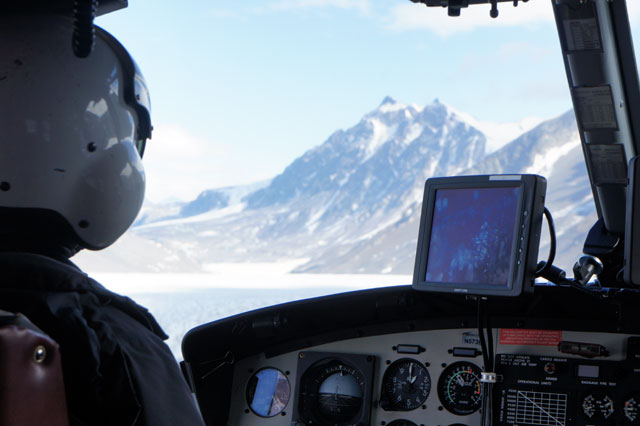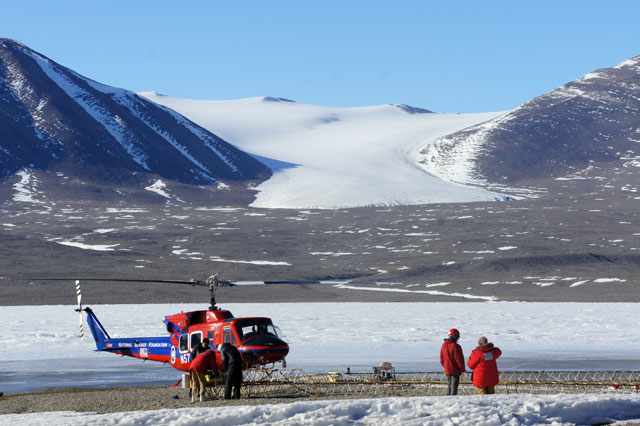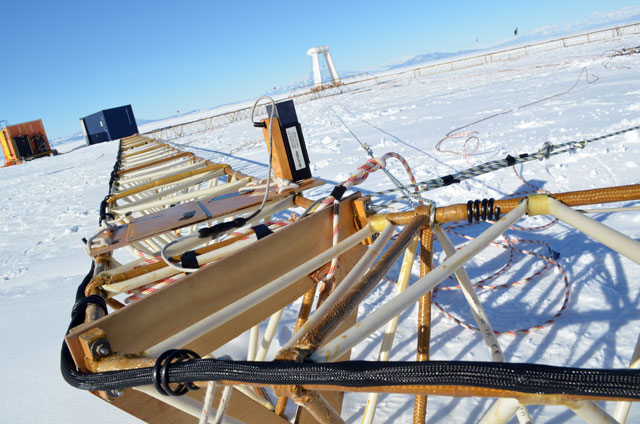|
Scratching beneath the surfaceScientists test electromagnetic method to learn more about underground processesPosted February 3, 2012
A method originally developed to find groundwater in Denmark might have research applications in Antarctica, from mapping the geology of a unique valley system and determining the ecological relationships with the subsurface structures to finding geothermal connections between the marine system and an active volcano. U.S. Antarctic Program (USAP) So far, preliminary data from a series of helicopter flights during the 2011-12 field season towing the large, octagon-shaped instrument across the McMurdo Dry Valleys “It allows us to explore large areas, and better understand the coastal margins of Antarctica, which I think we haven’t been able to explore before in this broad, systematic way,” said Jill Mikucki, now an assistant professor at the University of Tennessee, Knoxville The TEM in SkyTEM stands for “transient electromagnetic method,” “That’s the reason the frame is so big, because you need a large area in order to create a magnetic field,” explained Kurt Sørensen, a professor at Denmark’s Aarhus University Once the magnetic field has stabilized — a matter of milliseconds — the current is turned off and the magnetic field starts to decay. Eddy currents from the decaying magnetic field penetrate into the ground, creating a secondary magnetic field that’s measured by rudder-shaped dual receivers on the transmitter frame. The lifetime of the eddy currents depends on the type of material below the surface. The second magnetic field will last longer traveling through a good conductor, like saltwater, versus a material with low conductivity, also known as high resistivity, such as ice. Think of it as a big scanner that induces currents into the ground; the velocity of those currents is then dependent on the conductivity of the materials, explained Esben Auken, also a professor at Aarhus University who was involved in developing the SkyTEM method. “The conductivity structure is related to the geology,” he said. How deep can SkyTEM probe? Again, it depends on conductivity or resistivity. An ice layer atop salty sediment might allow the magnetic field might to penetrate several hundred meters. But a highly conductive top layer would probably absorb the magnetic field before it got down more than 30 meters or so. The large transmitter loop dangles on a cable about 40 meters below a helicopter, which carries the instrument about 30 meters off the ground. It weights about 400 kilograms. Pilots can’t fly any faster than about 35 knots, or 65 kilometers per hour, to ensure the integrity of the data. “It’s like flying with a giant parachute. It’s a lot of drag, but it flies really smoothly,” said helicopter pilot Paul Murphy after his first test run with the SkyTEM transmitter loop. In little more 20 hours of flight time, the helicopters flew more than 1,000 kilometers of flight lines, covering about 250 square kilometers. A primary target of the project was the McMurdo Dry Valleys, a relatively ice-free area of the continent near McMurdo Station The McMurdo Dry Valleys LTER “What we’re interested in is landscape processes,” she explained. “It’s always this challenge of scale, and so if we can scan these broad areas and get an image, and scan over where those boreholes are and correlate that to the stratigraphy we see there, then we can paint with a much broader brush — the extent of permafrost, where it changes, how the lakes are interacting with the sediments below them.” Ross Virginia “This presents a new opportunity to try to better understand the connections between the soils, the subsurface, and lakes, the margins around the lakes — these contact areas,” he said, adding that LTER scientists are particularly interested in recent influences within the ecosystem by persistent meltwater in the brief Antarctic summer. “We’re seeing more and more water appearing in the Valleys, seeping out of slopes, coming up into the soils,” said Virginia, who is also a co-PI on the SkyTEM project. “It’s just a new way for us to look at the Dry Valleys.” For Mikucki, the SkyTEM data may provide additional insights into a bizarre ecosystem that exists somewhere below Blood Falls In 2009, she and her colleagues reported in the journal Science of finding samples of unique bacteria in the briny liquid that seeps out of the mouth of the glacier from a subglacial pool several hundred meters below. The researchers believe that without light the microbes have survived over at least the last 1.5 million years to by metabolizing sulfur and iron compounds to survive. [See previous article — Ancient microbes: Unique community of bacteria found beneath Antarctic glacier.] “We’re hoping that SkyTEM could shed some light on that system under the Taylor and where it’s localized and the size of it to some extent,” she said. “This can provide a bigger picture of the ecosystem itself that exists below the glacier.” The SkyTEM data could also help researchers studying what they believe to be ancient ice buried underneath sediments in the Dry Valleys. Meanwhile, volcanologist Phil Kyle from New Mexico Tech “We’re trying to test the SkyTEM technology in a variety of systems down here,” she said. NSF-funded research in this article: Jill Mikucki University of Tennessee, Knoxville and Ross Virginia, Dartmouth College, Award No. 1043618
|



For USAP Participants |
For The Public |
For Researchers and EducatorsContact UsU.S. National Science FoundationOffice of Polar Programs Geosciences Directorate 2415 Eisenhower Avenue, Suite W7100 Alexandria, VA 22314 Sign up for the NSF Office of Polar Programs newsletter and events. Feedback Form |







